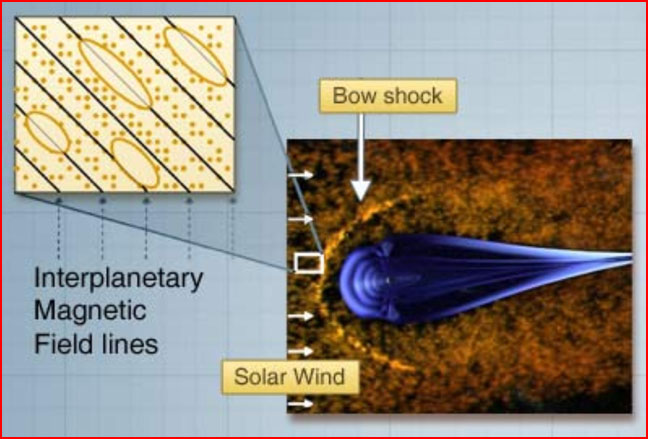
home •
about •
essential guide •
picture of the day •
thunderblogs •
news •
multimedia •
predictions •
products •
get involved •
contact
picture of the day archive subject index
In this illustration by European Space Agency artists, we see the Earth lying within the magnetosphere,
rendered in blue and surrounded by the solar wind. The white rectangle on the left identifies the area where
ESA’s Cluster and China/ESA Double Star’s satellites discovered “density holes.” The brown dots represent
the solar wind and ions “back-streaming against the solar wind flow,” along the interplanetary
magnetic field lines (in black). Credit: ESA
Jul 04, 2006
“Fizzy Bubbles” or Plasma Layers?Evidence continues to mount that the space surrounding Earth is rife with electrical activity. Where mainstream astronomers see “superhot gases” that “pop” and “fizz,” proponents of the Electric Universe see plasma double layers doing what they are observed to do in plasma experiments.
The European Space Agency recently observed anomalous “bubbles” that seemed to grow and pop around Earth. According to the Space.com report, “Astronomers found the activity up where Earth's magnetic field meets a constant stream of particles flowing out from the Sun.”
The researchers announcing the discovery spoke of “superhot gases” associated with the “bubbles.” They envisioned a “bow shock” formed as the result of the solar wind colliding with Earth’s magnetic field. The “temperature” in the gas bubbles is 18,000,000 Fahrenheit, a hundred times hotter than the temperature of the surrounding “hot gas.”
The researchers were following the only line of reasoning allowed by their training, which discusses “gases” in space in the mechanical language of wind and water behavior. Their theoretical framework excludes the possibility of any electrical interaction between the earth and the circuitry of the solar system. Astrophysicists work with a form of plasma theory called magnetohydrodynamics, which was first proposed by — and later repudiated by — Hannes Alfven, who investigated actual plasma behavior in both laboratory and space settings. He spent the latter part of his life warning astrophysicists that their assumptions were invalid in space. If the assumptions are incorrect, then the language used to describe the phenomena is wrong and misleading. While most astronomers only think of space plasma as a “gas,” plasma surrounding the earth frequently displays an electrically charged nature.
Since the 1960’s, space probes have revealed that Earth’s auroras are caused by electrical currents flowing from the Sun – a fulfillment of the prediction of plasma pioneer Christian Birkeland. The Earth’s magnetospheric “bubble” is actually a Langmuir sheath that is electrically coupled to currents flowing in the Sun's heliospheric sheath. Sheaths are composed of electrically charged double layers of plasma, in which layers of opposite charge build up very near each other with a strong electric field between them. These double layers accelerate ions to high velocities that, when interpreted as temperature, appear to be very “hot.”
Two regions of dissimilar plasma will form a Langmuir sheath between them, which may result in a “bubble” formation. Electrical theorists such as Wallace Thornhill suggest that the so-called “fizzy bubbles” are most likely sheath-bounded cells of plasma. They are more than a magnetic effect in gas: they will exhibit charge differential, ion acceleration and radiation over a wide band from radio to x-ray—all suggesting a much different line of investigation than that implied by the story of “fizzy bubbles” in space.
___________________________________________________________________________Please visit our Forum
The Electric Sky and The Electric Universe available now!

|
|

|
EXECUTIVE EDITORS:
David Talbott, Wallace Thornhill
MANAGING EDITORS:
Steve Smith, Mel Acheson
CONTRIBUTING EDITORS: Dwardu Cardona, Ev Cochrane,
C.J. Ransom, Don Scott, Rens van der Sluijs, Ian Tresman
WEBMASTER: Brian Talbott
Copyright 2006: thunderbolts.info
![]()
home •
thunderblogs •
forum •
picture of the day •
resources •
team •
updates •
contact us

